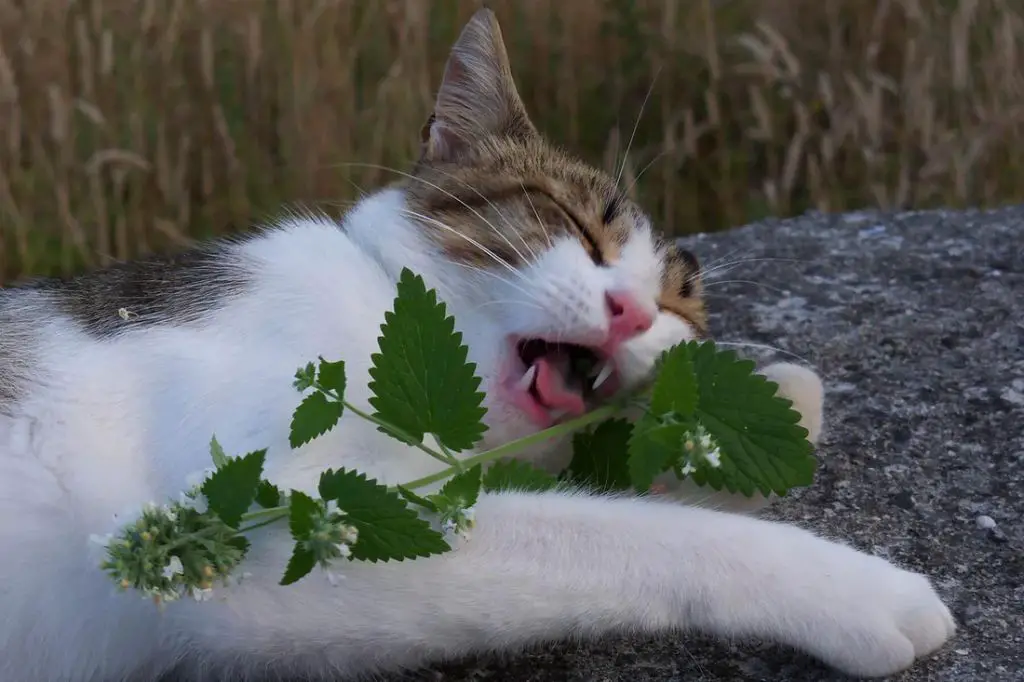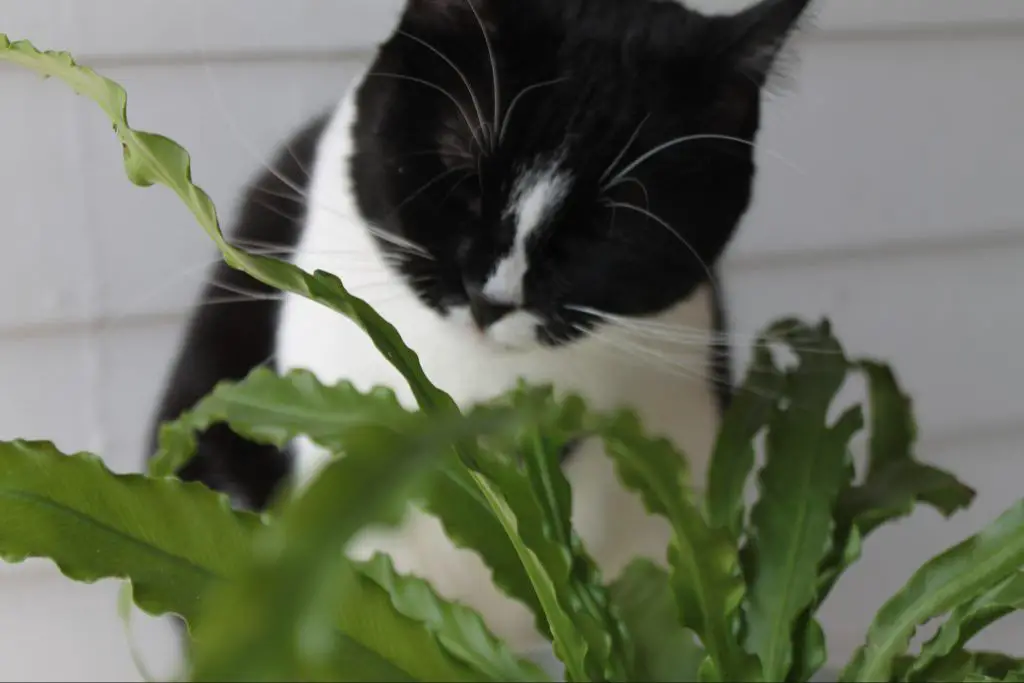What is Catnip and How Does it Affect Cats?

Catnip is an herb in the mint family that contains a chemical called nepetalactone (1). This chemical triggers a response in some cats’ brains that makes them act hyperactive and playful. When cats smell or eat catnip, the nepetalactone binds to receptors in their brain and causes a temporary euphoric state (2).
Not all cats are affected by catnip. Studies show that around 50-70% of cats respond to catnip, with the tendency being genetic (1). For cats that are sensitive to catnip, effects can include rolling around, pawing at the air, hyperactivity, vocalizations, and playing with toys. The effects typically last around 5-15 minutes before wearing off (2).
Catnip is safe for cats to consume in moderation. However, too much can cause vomiting, diarrhea or other digestive issues (2). It’s generally recommended to limit catnip exposure to a few times per week at most.
Sources:
(1) https://www.humanesociety.org/resources/crazy-catnip
(2) https://www.petmd.com/cat/general-health/what-is-catnip
Does Catnip Have Any Effect on Dogs?

Most dogs do not respond to catnip in the same way cats do (1). However, some dogs may show mild interest or excitement around catnip. The nepetalactone in catnip does not appear to trigger a strong neurological response in dogs like it does in cats (2).
While most dogs lack the innate reaction to catnip that cats have, a small subset of dogs may get mildly excited by catnip smells or plant matter. Some behaviors like sniffing, licking, or chewing at catnip toys or plants have been observed in dogs (3). However, the euphoric “high” that cats experience has not been documented in dogs.
Overall, catnip does not elicit an intense neurological or behavioral response in most canines. While a small number of dogs may show curiosity for the smell or taste of catnip, it does not appear to have significant physiological or mental effects on them.
(1) https://www.dailypaws.com/dogs-puppies/dog-safety-tips/catnip-for-dogs
(2) https://blog.healthypawspetinsurance.com/is-catnip-safe-for-dogs
(3) https://sports.yahoo.com/catnip-dogs-safe-vet-explains-232722783.html
Possible Mild Effects of Catnip on Dogs
While catnip does not have the same stimulating effects on dogs as it does on cats, some dogs may show curiosity or mild interest when exposed to catnip. According to the ASPCA, around 10-30% of dogs may sniff, lick, or even eat catnip without any adverse effects (source).
Dogs have far fewer olfactory receptors compared to cats, which means they do not respond to the nepetalactone compound in catnip in the same euphoric way. However, a small percentage of dogs may still be mildly attracted to the smell or taste of catnip. These dogs may sniff, lick or even gently chew on catnip toys or plants.
While mild curiosity is normal, catnip should still be kept safely away from dogs. Large ingestions can potentially cause vomiting, diarrhea or other gastrointestinal upset in dogs. The ASPCA recommends storing catnip securely out of a dog’s reach and supervising anytime a dog is exposed to catnip (source).
Why Doesn’t Catnip Affect Most Dogs?
Catnip, also known as Nepeta cataria, contains an organic compound called nepetalactone that binds to receptors in a cat’s brain, causing a temporary euphoric effect 1. However, according to the ASPCA, dogs lack the specific catnip-sensitive receptors that allow the nepetalactone to have an effect 2.
Without those specialized olfactory receptors in their brains, most dogs do not experience any neurological response when exposed to or after ingesting catnip. While some dogs may show a very mild reaction, it is nowhere near the euphoric “high” that catnip induces in cats.
The reason cats have evolved this reaction to nepetalactone is still not fully understood. One theory suggests the chemical mimics feline pheromones and triggers a response similar to sexual arousal or territorial displays in cats.
Can Catnip Be Harmful to Dogs?

While catnip itself is generally safe for dogs, eating large amounts can cause an upset stomach. According to the ASPCA, some signs of catnip toxicity in dogs include diarrhea, vomiting, and lethargy[1]. However, serious toxicity is rare.
Some dogs may also have allergic reactions to catnip and experience itchy skin, hives, or irritation when exposed to the herb. If a dog shows signs of an allergic reaction, owners should consult their veterinarian.
Otherwise, catnip is not directly toxic or poisonous to dogs. The main concern is gastrointestinal upset if dogs eat a large quantity of dried catnip or catnip toys. Mild diarrhea or vomiting may occur, but this can generally be managed at home unless symptoms are severe.
In summary, while not inherently dangerous, catnip can cause stomach upset if dogs ingest too much. Consulting a vet is recommended if a dog has a known catnip allergy or serious reaction after exposure.
[1] https://www.aspca.org/pet-care/animal-poison-control/toxic-and-non-toxic-plants/catnip
Signs of Catnip Toxicity in Dogs
Although rare, some dogs may experience signs of toxicity if they ingest too much catnip. According to the ASPCA, symptoms of catnip toxicity in dogs can include:1
- Vomiting and diarrhea
- Drooling
- Lethargy and lack of coordination
- Swollen tongue or lips
- Difficulty breathing
These symptoms tend to occur within a few hours of a dog consuming a large amount of catnip. The exact amount that can cause toxicity is not known, as it can vary greatly between dogs based on size and individual sensitivity.2 Mild gastrointestinal upset may occur with smaller amounts.
What to Do if a Dog Eats Catnip
If your dog eats a small amount of catnip, the most common reaction will be mild gastrointestinal upset. Monitor for signs of nausea or diarrhea. The effects should pass within a few hours as the catnip moves through your dog’s digestive system.
Call your veterinarian right away if your dog exhibits severe vomiting or diarrhea after eating catnip. Uncontrolled vomiting and diarrhea can quickly lead to dehydration in dogs (source: https://sundaysfordogs.com/blog/can-dogs-eat-catnip-is-it-safe-for-them-to-eat).
Some dogs may have an allergic reaction to catnip with symptoms including swollen lips, hives, or excessive itching. Contact your vet immediately if swelling or other allergic reaction symptoms develop.
Going forward, keep all sources of catnip out of your dog’s reach. If your dog shows mild interest in catnip, distract them with a favorite toy. Prevent access to large quantities of catnip, which could lead to an upset stomach.
Safer Alternatives to Catnip for Dogs
For dogs that enjoy herbal scents and mental stimulation, there are many safer alternatives to catnip that provide similar benefits without the risks.
Many herbs that are safe for dogs can elicit a pleasant response when smelled. According to The Spruce Pets[1], chamomile, mint, parsley, oregano, dill, fennel, basil, lemon balm, and valerian can provide calming effects for anxious pups. These herbs can be dried or fresh and given to dogs to sniff and chew.

Food puzzle toys stuffed with dog-safe foods are excellent for providing mental enrichment. As dogs work to get the treats out, they are kept occupied and engaged. The Spruce Pets recommends food puzzles like the Kong, the Twist ‘n’ Treat, or snuffle mats[2].
Sniff mats or aromatherapy mats allow dogs to explore scents in a safe way. These mats can be laced with dog-safe aromatics like anise, vanilla, peppermint, or lavender to create a puzzle for pups to solve with their nose according to Canine Journal[3]. Supervision is still recommended with these tools.
With some creativity and care, dog owners can provide their pooches with fun sensory experiences without using catnip.
Keeping Cats and Dogs Safe
You can keep your cats and dogs happy and safe by careful supervision and separation of their play areas:
Store catnip securely away from dogs to prevent accidental ingestion. Keep it in an airtight container in a high cabinet or closet.
Supervise catnip play sessions with cats to ensure your dog isn’t tempted to jump in and eat the catnip. Provide separate pet play areas in your home for cats and dogs.
Distract dogs from catnip with obedience training. Teach your dog the “leave it” command so they know not to touch the catnip toys.
By keeping the catnip play space separate and training your dog, you can let your cat enjoy their catnip while ensuring your dog’s safety.
The Bottom Line
Catnip generally does not affect dogs like it does cats. Dogs lack the receptor in their brain that causes the euphoric reaction in cats when they smell or ingest catnip. While some dogs may show mild interest in catnip, it does not cause the same intense response as it does in cats.
It’s best to keep large quantities of catnip put away and out of reach of dogs. Eating a large amount can potentially cause stomach upset. Monitor any mild interest your dog shows in catnip and be sure to distract them with more appropriate chew toys.
If your dog happens to eat a large amount of catnip, contact your veterinarian. Signs of catnip toxicity can include vomiting, diarrhea, lethargy and lack of coordination. Your vet can provide the proper treatment to avoid serious illness.
Overall, catnip is generally safe for dogs but does not provide the same euphoric effects as it does for cats. Keep quantities of catnip away from dogs, monitor mild interest and be sure to contact your vet if a large amount is ingested.

